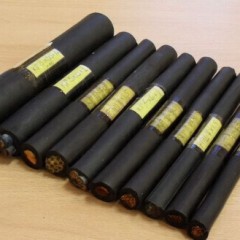Which wire to use to assemble the shield
What does an electrical panel consist of?
An input cable is connected to the electrical panel through the holes in the housing, and then connections to electrical equipment are made in accordance with the scheme. For example, when shield assembly the power cable is connected to the input circuit breaker, and the corresponding equipment, which belongs to each group of consumers, is already connected to it.
Inside a modern home electrical panel there are a large number of different switching and protective devices and equipment of a different type, including:
- metering device (electricity meter).
- circuit breakers (introductory or disconnecting groups and individual consumers);
- RCD and difavtomaty;
- timers;
- voltage relay;
- phase control relay;
- other automation.
The body of the electrical panel must be grounded, its metal doors and other live parts too. To limit access by unauthorized persons and to prevent electric shock, it must be locked with a key.
What should be the wire
The requirements that are put forward for cable products of any kind are determined from the conditions in which they are used and laid. In an electrical panel, due to the limited space during its assembly, the need for compact wiring is required. Therefore, during assembly, the wire for the electrical panel bends in accordance with the scheme for connecting the functional elements. This leads to the condition that the wire should normally withstand bending, so aluminum conductors are poorly suited for this purpose - they break after several bends. Therefore, preference should be given to copper conductors.
The wires are distinguished by the flexibility class, which depends on the core design - monolithic (single-wire) and multi-wire. Monolithic conductors, although difficult to bend, can be directly connected to terminals and screw terminals. In addition, flexibility after installation in an electrical panel is not needed.
It is more convenient to work with a flexible multi-wire core during assembly, but there is a significant problem - it cannot be used to connect to terminals and screw terminals, which are used in all automatic machines and other equipment. To connect a flexible wire to such a terminal, you must either tin the end or compress it tip type NShVI or NShVI2 and the like. If you neglect this, the contact will turn out to be unreliable and short-lived.
Given all the above, we can conclude that domestic wires are suitable for installation in an electrical panel:
- PV-1 (PuV) - single-wire copper core, single PVC insulation, flexibility class 1.

- PV-3 (PuGV) - multi-wire copper core, PVC insulation, 2nd class of flexibility - 0.5 to 1.5 mm2; flexibility class 4 - from 2.5 to 4 mm2; flexibility class 3 - sections exceeding 4 mm2.

- PV-4 - multi-wire copper core, PVC insulation, more flexible than the previous one, depending on the cross-section, PV-4 has a 4 or 5 class of flexibility.

There are foreign analogues - H05VK, H07VK at 0.5 and 0.75 kV, respectively.
The cross section is selected in accordance with the currents that will flow through the conductor.
It is also worth remembering that there is standard colors for wires by appointment:
- phase - gray or black;
- zero is blue;
- the earth is yellow-green.
In this case, it is necessary to carry out such installation so that there is no sagging of the wire (especially for multi-wire cores) and unnecessary excesses (this applies to monolithic cores). For this, it is necessary to determine in advance the required length of the wire, and then cut off 2-3 cm more to ensure a normal input of the end into the terminal of the machine.
Connections in the switchboard with the input circuit breaker of the consumer group are made using jumpers between adjacent circuit breakers, for this you can use a flexible and rigid wire with a single-wire core, but the latter is more convenient since you do not need to use the tips of the NShVI. It is better to avoid jumpers at all, if possible and use connecting bus. It is rigid, the contact will be good, and the installation will be visual and aesthetic.
Finally, we recommend watching a useful video on the topic:
Now you know how to choose a wire for the assembly of the electrical panel in a private house or apartment. We hope that the information provided was useful and understandable to you!
Related materials:













"" "" "" »To connect a flexible wire to such a terminal, you must either tin the end» »» »» »
You can not solder (tin) multicore wires: it is much worse than just leaving it as it is. Tin is fluid (not flowing, not under load, but simply “fluid” - see Google) and the contact will constantly weaken.
Eeee ... but why tighten the terminals with a screwdriver?
There are special screwdrivers plus / minus and even with torque limiters to different values.